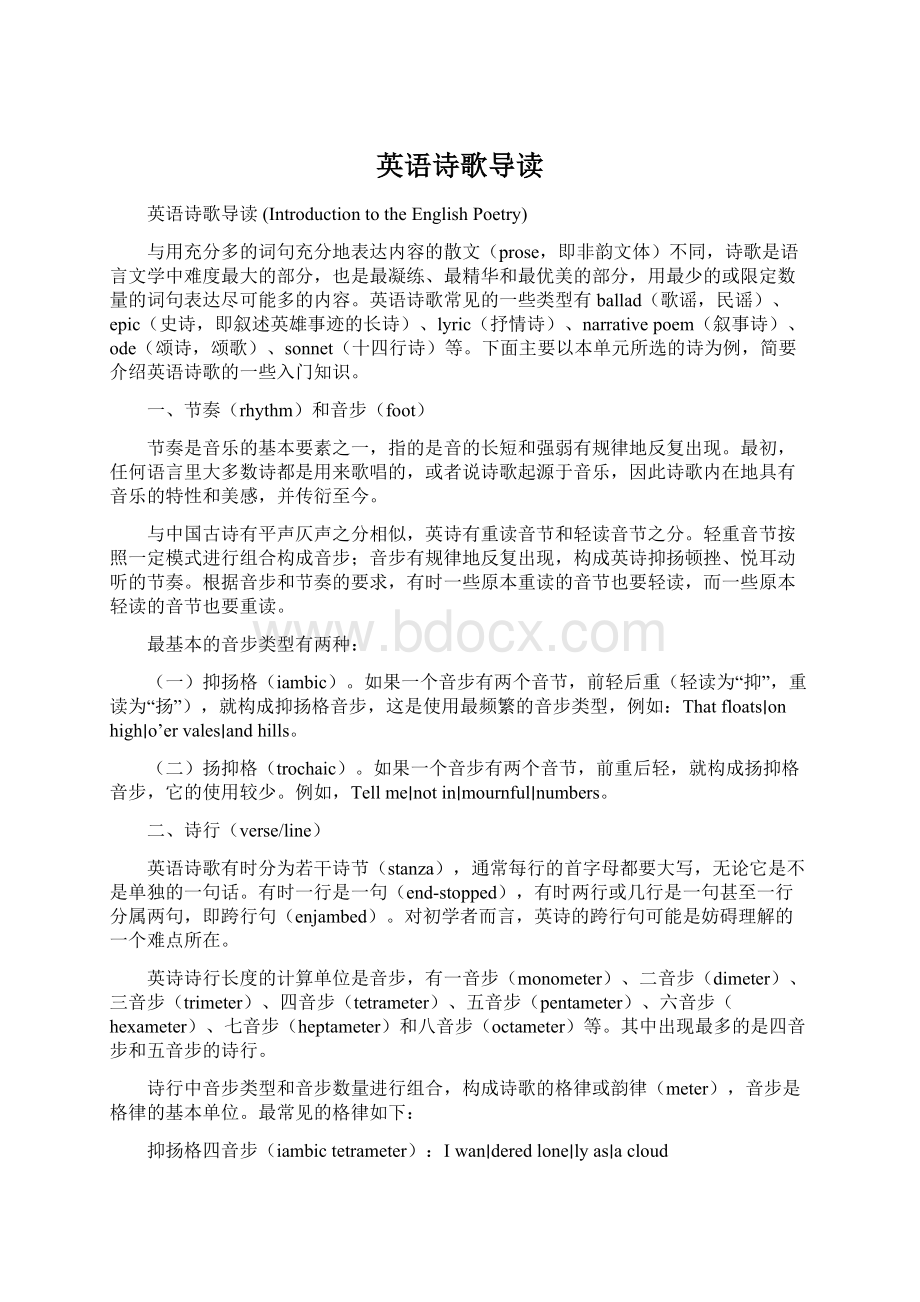英语诗歌导读.docx
《英语诗歌导读.docx》由会员分享,可在线阅读,更多相关《英语诗歌导读.docx(22页珍藏版)》请在冰豆网上搜索。

英语诗歌导读
英语诗歌导读(IntroductiontotheEnglishPoetry)
与用充分多的词句充分地表达内容的散文(prose,即非韵文体)不同,诗歌是语言文学中难度最大的部分,也是最凝练、最精华和最优美的部分,用最少的或限定数量的词句表达尽可能多的内容。
英语诗歌常见的一些类型有ballad(歌谣,民谣)、epic(史诗,即叙述英雄事迹的长诗)、lyric(抒情诗)、narrativepoem(叙事诗)、ode(颂诗,颂歌)、sonnet(十四行诗)等。
下面主要以本单元所选的诗为例,简要介绍英语诗歌的一些入门知识。
一、节奏(rhythm)和音步(foot)
节奏是音乐的基本要素之一,指的是音的长短和强弱有规律地反复出现。
最初,任何语言里大多数诗都是用来歌唱的,或者说诗歌起源于音乐,因此诗歌内在地具有音乐的特性和美感,并传衍至今。
与中国古诗有平声仄声之分相似,英诗有重读音节和轻读音节之分。
轻重音节按照一定模式进行组合构成音步;音步有规律地反复出现,构成英诗抑扬顿挫、悦耳动听的节奏。
根据音步和节奏的要求,有时一些原本重读的音节也要轻读,而一些原本轻读的音节也要重读。
最基本的音步类型有两种:
(一)抑扬格(iambic)。
如果一个音步有两个音节,前轻后重(轻读为“抑”,重读为“扬”),就构成抑扬格音步,这是使用最频繁的音步类型,例如:
Thatfloats∣onhigh∣o’ervales∣andhills。
(二)扬抑格(trochaic)。
如果一个音步有两个音节,前重后轻,就构成扬抑格音步,它的使用较少。
例如,Tellme∣notin∣mournful∣numbers。
二、诗行(verse/line)
英语诗歌有时分为若干诗节(stanza),通常每行的首字母都要大写,无论它是不是单独的一句话。
有时一行是一句(end-stopped),有时两行或几行是一句甚至一行分属两句,即跨行句(enjambed)。
对初学者而言,英诗的跨行句可能是妨碍理解的一个难点所在。
英诗诗行长度的计算单位是音步,有一音步(monometer)、二音步(dimeter)、三音步(trimeter)、四音步(tetrameter)、五音步(pentameter)、六音步(hexameter)、七音步(heptameter)和八音步(octameter)等。
其中出现最多的是四音步和五音步的诗行。
诗行中音步类型和音步数量进行组合,构成诗歌的格律或韵律(meter),音步是格律的基本单位。
最常见的格律如下:
抑扬格四音步(iambictetrameter):
Iwan∣deredlone∣lyas∣acloud
抑扬格五音步(iambicpentameter):
ShallI∣compare∣theeto∣asum∣mer’sday?
许多英语诗歌要求每行音节数量的一致;类似地,汉语诗歌要求字数相同其实也是音节数的相同。
英语诗人为了达到每行音节数量的一致,有时需要对某些词语的拼写进行调整,以减少某些多余的音节,比如because写成’cause,就减少了一个音节。
类似的还有:
i’(in)、o’er(over)、oft(often)、reap’d(reaped)、whoe’er(whoever)等。
三、押韵(rhyme)
和汉语诗歌一样,英语诗歌一般也押韵。
押在诗行最后一个音节上的韵,称为尾韵(endrhyme),又称韵脚,这是英诗最重要的押韵位置。
每节诗的尾韵具有押韵格式,简称韵式(rhymescheme),通常用字母表示。
例如RobertFrost的“StoppingbyWoodsonaSnowyEvening”,其四节的韵式分别是aaba(第一、二、三节)和dddd(第四节)。
一行诗中间的音节与最后一个音节押韵的,称为行内韵(internalrhyme),如:
Spring,thesweetspring,istheyear’spleasantking。
一行诗中的一些词用相同的字母或声韵开头,称为头韵(alliteration),如:
Thewoodsarelovely,darkanddeep。
押韵还有男韵(masculinerhyme)和女韵(femininerhyme)之分。
所押的韵在诗行最后的重读音节上,称为男韵或单韵,其特点是雄壮有力。
所押的韵在诗行最后的轻读音节上,称为女韵或双韵,其特点是轻快温婉。
也有一些英诗不押韵,称为无韵诗(blankverse),它与压韵诗(rhymedverse)相对。
无韵诗虽然不压韵,但有固定的格律,这与自由诗(freeverse)不同,因为自由诗既不押韵,也没有固定的格律。
四、英诗词汇的一些特点
英语诗歌为了达到某种艺术效果(如古朴、典雅、保持每行音节数一致等),有时会使用一些古老词汇或诗歌专用词汇,例如vale(valley)、behold(see)、yon(yonder,there)、hark(listen)、clime(climate)等。
读者也需要注意一些具有中古英语拼写方式的词汇。
例如thou(you的主格形式)、thee(you的宾格形式)、thy(your)、thine(your,用在以元音字母或h开头的词语之前)、art(are)、hath(has)、dost(do的第二人称现在式)。
其中,与dost情形相似的还有莎士比亚第十八首十四行诗中的ow’st、grow’st、wander’st等。
五、英诗的省略和倒装
由于节奏、押韵等方面的需要,英语诗歌有时会在诗行中省略某些词语或句子成分(主语、谓语、宾语等)。
例如下面蒲伯的一节诗中,
Whoseherdswithmilk,whosefieldswithbread,
Whoseflockssupplyhimwithattire,
Whosetreesinsummeryieldhimshade,
Inwinterfire.
第一行两个短句中间各省略了supplyhim;第四行行首省略了Whosetrees,fire之前省略了yieldhim。
英语诗歌的句子,有时会使用倒装结构,以达到某种艺术效果,或者使句子压韵。
例如:
WhosewoodstheseareIthinkIknow,意思是IthinkIknowwhosewoodstheseare;everyfairfromfairsometimesdeclines,意思是everyfairsometimesdeclinesfromfair。
Unit12EnglishPoems
1.Sonnet18
WilliamShakespeare
ShallIcomparetheetoasummer’sday?
[1]
Thouartmorelovelyandmoretemperate:
RoughwindsdoshakethedarlingbudsofMay,
Andsummer’sleasehathalltooshortadate:
Sometimetoohottheeyeofheavenshines
Andoftenishisgoldcomplexiondimmed;
Andeveryfairfromfairsometimesdeclines;
Bychanceornature’schangingcourseuntrimmed;
Butthyeternalsummershallnotfade,
Norlosepossessionofthatfairthouow’st;
Norshalldeathbragthouwander’stinhisshade,
Whenineternallinestotimethougrow’st:
Solongasmencanbreathe,oreyescansee,
Solonglivesthis,andthisgiveslifetothee.
Notes:
summer’slease:
thedurationofsummer
date:
time
sometime:
sometimes
theeyeofheaven:
thesun
everyfairfromfairsometimesdeclines:
everybeautifulthingsometimeslosesitsbeauty.Thefirstfairmeansabeautifulthing,andthesecondonemeansbeingbeautiful.
eternallines:
immortalpoetry
Aboutthepoet:
WilliamShakespeare(1564-1616)wasthemostfamousofallEnglishwriters.Hewasknownasthebestplaywrightinhumanhistory,whowrote37immortalplays,suchasHamletandRomeoandJuliet.Hishumanisticpursuits,hisprobationintohumannature,andhissuperbmasteryofEnglishcanalwaysbefoundinhisplays.Hislanguageisrichinmeaning,vividinimages,andbeautifulinartisticquality.HehasbeenoneofthemostimportantinfluencesupontheEnglishlanguage.
Alsobeingapoet,Shakespearewrotetwolongpoemsand154sonnets.Thepoeticformofsonnetoriginatedfrom13th-centuryItaly,andwasintroducedintoBritainintheearly16thcentury.Itisapoemof14lineswithastrictrhymeschemeandasequenceofmeanings.Shakespeareansonnetconsistsofthreequatrains(fourlines)andonecouplet(twolines);thecoupletusuallyembodiesasharpturninthemeorimage.Hisfamousrhymeschemeisabab,cdcd,efef,gg;andheemployediambicpentameter.Someofhissonnetsweredevotedtoahandsomeyoungmanwhomheadmired,andotherstoadark-skinnedyoungladywhomhehadastrongpassionfor.
Interpretingthepoem:
Thissonnetportrays
thebeautyofayoungmanbycomparinghimwithnaturalscenes,emphasizingthatnature’sbeautycouldnotmatchhis.Thepoetmadeimmortaltheyoungmanandart(poetry)inthissonnet.
Inquatrain1,thespeakercomparestheyoungmanwithasummer’sday,andbelievesthatheismorebeautiful(“Thouartmorelovelyandmoretemperate”).Inlines3and4,thespeakernarratesthattheflowersofMaycanbeeasilydestroyed,andsummeristooshort.
Inquatrain2,thespeakercontinuestodescribethetransienceofnaturalbeauty:
theshining,goldensuncanbeshadedbythecloud;everybeautifulthingsometimesdiminishes,whichiscausedbychancesorbynature’schangingcourse.
Inquatrain3,thespeakerstressestheyoungman’seternalexistence:
hisbeautywillnevervanishandhewillneverdie,becausehewillliveforeverinthiseternalpoem.
Thecoupletcomestotheconclusion:
solongasmanlivesontheearth,thispoemwilllive;solongasthispoemlives,itwillgiveeverlastinglifetotheyoungman.
Insummary,thepoetdescribedtheeternalbeautyoftheyoungman;bydoingsoheconveyedadeepermeaning:
art(poetry)isimmortal.Andthissonnetisimmortal,too.
Comprehensionquestions:
1.Thepoetwastodescribetheyoungman’sbeauty,butwhydidhewriteaboutthebeautyofnature?
2.Whyisthebeautyofnaturetransientandthatofthearteverlasting?
Students’activities:
Discusswithyourpartners:
Ifyouweretowriteabouttherelationbetweenthebeautyofnatureandthatofaperson,whatwouldyouthinkofinyourmind?
Why?
2.IWanderedLonelyasaCloud
WilliamWordsworth
Iwanderedlonelyasacloud
Thatfloatsonhigho’ervalesandhills,
WhenallatonceIsawacrowd,
Ahost,ofgoldendaffodils;
Besidethelake,beneaththetrees,
Flutteringanddancinginthebreeze.
Continuousasthestarsthatshine
Andtwinkleonthemilkyway,
Theystretchedinnever-endingline
Alongthemarginofabay:
TenthousandssawIataglance,
Tossingtheirheadsinsprightlydance.
Thewavesbesidethemdanced,butthey
Out-didthesparklingwavesinglee:
Apoetcouldnotbutbegay,
Insuchajocundcompany:
Igazed—andgazed—butlittlethought
Whatwealththeshowtomehadbrought.
Foroft,whenonmycouchIlie
Invacantorinpensivemood,
Theyflashuponthatinwardeye
Whichistheblissofsolitude;
Andthenmyheartwithpleasurefills,
Anddanceswiththedaffodils.
Notes:
jocund:
joyous
inwardeye:
eyeofthesoul
Aboutthepoet:
WilliamWordsworth(1770-1850)wastheestablisheroftheEnglishliteraryRomanticMovement.HewasbornintheLakeDistrict,wherethelandscapedeeplyappealedtohim,helpednurturehisloveofnature,andprovidedafountainheadforhispoeticcreation.Knownasa“worshiperofnature,”healwaysdrewinspirationfromandwroteaboutnatureandordinarylife,andheintegratedhisprofoundthoughts,ingeniouspoeticgift,loveofnature,andsimplelanguageinhispoems,asheoncesaid:
“Allgoodpoetryisthespontaneousoverflowofpowerfulfeelings.”HewasknownasoneoftheLakePoets,togetherwithColeridgeandRobertSouthey.In1843,hebecamePoetLaureate.HismasterpiecesincludeLyricalBallads,“Prelude,”“IWanderedLonelyasaCloud,”“LinesComposedaFewMilesaboveTiternAbbey,”etc.
Interpretingthepoem:
ThisisoneofthebestknownEnglishpoems.Thepoetrecordedhisunexpectedseeingofmanydaffodilsduringalonelywalk.Thedaffodils,asymbolofnaturalbeauty,pleasedhiseyesthenandenabledhimtodrawspiritualwealthtwoyearslater.Withhiscarefulchoiceofimages,lovelyrhetoricaldevices,andsimplepoeticlanguage,hearticulatedthatnaturecouldinspiremanwhennothingelsecould.Hemadeanexcellentuseofthemusicalqualityofpoeticlanguage:
employingamasculinerhymeschemeababccandwritinghislinesiniambictetrameter.
Instanza1,thespeakerwandereddullyandaimlessly“asacloud;”thenhesawalotofdaffodilsdancinginthebreezebesidethelake.
Instanza2,hedescribedthedaffodils’delightfuldancing“innever-endingline.”Theyseemedasjoyousandnumerousastheshiningstarsinthesky.
Instanza3,hecomparedthedaffodilswiththewaves:
eventhesparklingwaveswerenotasjoyousasthem.Thedepressedspeakerbecamecheeredup“Insuchajocundcompany”,butdidnotrealizewhatspiritualwealththescenebroughttohim.
Instanza4,whenhewasalonemuchlater,herecollectedthedaffodils;thenhissoulfelthappyand“danceswiththedaffodils.”
Therearethreemajorimagesinthepoem:
thedancingdaffodils,thewanderingcloud,andthesparklinglake.Thecloudandthedaffodilsstrokeacontrasttomakeachange(frombeingdepressedtobeingjoyous),whilethelakemadeacomparisonwiththedaffodilsinordertogiveprominencetothe